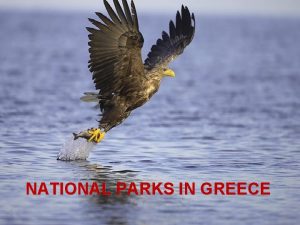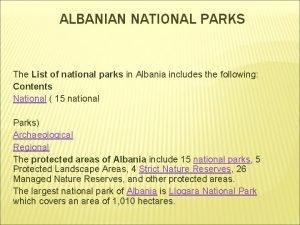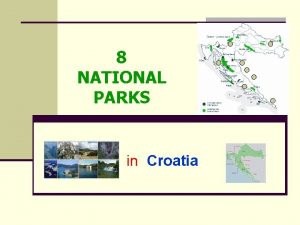Polish National Parks A Map of Polish National











- Slides: 11

Polish National Parks

A Map of Polish National Parks

Kampinoski National Park It is located in the central part of Poland, in the Mazowiecka Lowland. The Łasica River flows through the Park. The Kampinos National Park has many landscape features like coniferous forests, deciduous forests, and of course swamps. Its characteristic plants and animals are: pines, spruces, birches, alders, elks, beavers, lynxes.

Bieszczady National Park It is located in the Eastern Carpathians, in the upper part of the San River basin. It includes the highest hills of the Polish part of the Bieszczady Mountains. Above meadows, called połoniny. Characteristic for BNP are mainly beech and fir forests which reach up to the upper edge of the forest, which runs at an altitude of about 1150 m, while the fauna is bears, badgers, otters and wolves.

Greater National Park It is located south of Poznań, on the Warta. It was created on 16. 04. 1957. Pine forests are common there. However, when it comes to fauna, invertebrates are the most numerous. In the park there also badgers, shrews, woodpecker and kingfisher. The park area also includes several lakes.

Babia Góra National Park It is located in southern Poland, near the border with Slovakia. On the Slovak side there is a landscape park "Horná Orava". It covers the north and south sides of the Babia Góra massif. The park's fauna is deer, lynxes, wolves, bears, while flora includes beech, Norway spruce, fir, onion livestock, bear's garlic.

Białowieża National Park Located in the north-eastern part of Poland, in the Podlasie Province. The park's symbol is the bison, because it was in this park that this animal was saved from destruction. Bisons became extinct almost in the 18 th century. Their few populations survived only in the Caucasus and in the Białowieża Forest. Over 2/3 of the park area is covered by deciduous forests. The largest area is covered by oak-hornbeam forests that grow on the most fertile forest soils.

Ojców National Park It is located in the Lesser Poland Voivodship, in the Krakow Poviat, about 16 km from Krakow. It is located in the area of four communes: Skała, Jerzmanowice-Przeginia, Wielka Wieś, and Sułoszowa. It covers an area of 21. 46 km². The calcareous substrate promotes the formation of caves. Until 2006, about 500 caves and smaller caves were cataloged in the park. They arose mainly as a result of karst waters. The longest are: Łokietka Cave, Ciemna. The characteristic flora is alpine rose, paternal birch, calyx peristata, ova, and fauna include bat, roe deer, gray hare, European boar, red fox, European marten.

Wolin National Park Located in the West Pomeranian province, in the central-west part of the island of Wolin, between the Pomeranian Bay and the Szczecin Lagoon. On the island of Wolin, vascular plants have been found, including many protected species, e. g. sand breeze, coastal watercress and prickly brine. The inland park is dominated by moraine hills covered with beech, pine and oak forests. The main bird flight route along the Baltic coast runs through Wolin. In the park, more than 230 species of birds have been found, e. g. white-tailed eagle, Aquatic Warbler, Red-backed Sandpiper, Flycatcher

Wigry National Park The Wigry National Park is located on the northern edge of the Augustowska Forest, the fourth largest compact forest complex in Poland. Geographically, the Park lies within the borders of the Lithuanian Lake District and includes fragments of three mesoregions. In geobotanical terms, the Wigry National Park represents the region of north-eastern Europe, characterized by the domination of moss-covered pine and spruce coniferous forests. The beaver is a characteristic sign of the Wigry National Park.

http: //zpppn. pl/parki-narodowe https: //pl. wikipedia. org/wiki/Parki_narodowe_w_Polsce




















